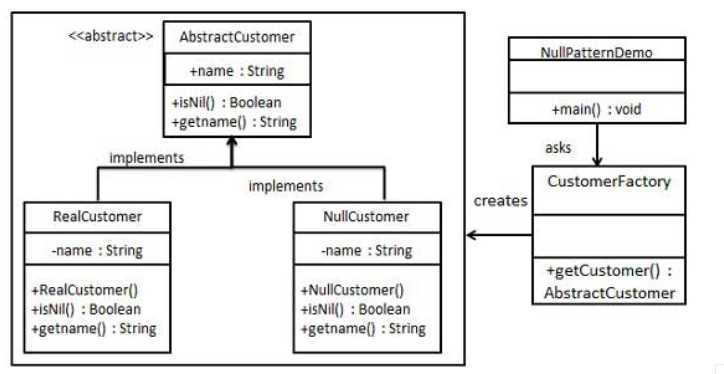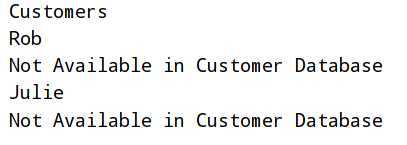在空对象模式(Null Object Pattern)中,一个空对象取代 NULL 对象实例的检查。Null 对象不是检查空值,而是反应一个不做任何动作的关系。这样的 Null 对象也可以在数据不可用的时候提供默认的行为。在空对象模式中,我们创建要给指定各种要执行的操作的抽象类和扩展该类的实体类,还创建一个未对该类做任何实现的空对象类,该空对象类将无缝地使用在需要检查空值的地方。
我们将创建一个定义操作(在这里,是客户的名称)的 AbstractCustomer 抽象类,和扩展了 AbstractCustomer 类的实体类。工厂类 CustomerFactory 基于客户传递的名字来返回 RealCustomer 或 NullCustomer 对象。
NullPatternDemo,我们的演示类使用 CustomerFactory 来演示空对象模式的用法。

1、创建一个抽象类
public abstract class AbstractCustomer { protected String name; public abstract boolean isNil(); public abstract String getName(); }
2、创建扩展了上述类的实体类
public class RealCustomer extends AbstractCustomer{ public RealCustomer(String name) { this.name = name; } @Override public String getName() { return name; } @Override public boolean isNil() { return false; } }
public class NullCustomer extends AbstractCustomer { @Override public String getName() { return "Not Available in Customer Database"; } @Override public boolean isNil() { return true; } }
3、创建 CustomerFactory 类
public class CustomerFactory { public static final String[] names = {"Rob", "Joe", "Julie"}; public static AbstractCustomer getCustomer(String name){ for (int i = 0; i < names.length; i++) { if(names[i].equalsIgnoreCase(name)){ return new RealCustomer(name); } } return new NullCustomer(); } }
4、使用 CustomerFactory,基于客户传递的名字,来获取 RealCustomer 或 NullCustomer 对象。
public class NullObjectPatternDemo { public static void main(String[] args) { AbstractCustomer customer1 = CustomerFactory.getCustomer("Rob"); AbstractCustomer customer2 = CustomerFactory.getCustomer("Bob"); AbstractCustomer customer3 = CustomerFactory.getCustomer("Julie"); AbstractCustomer customer4 = CustomerFactory.getCustomer("Laura"); System.out.println("Customers"); System.out.println(customer1.getName()); System.out.println(customer2.getName()); System.out.println(customer3.getName()); System.out.println(customer4.getName()); } }
输出

我们使用一个空对象代替了对象的判空处理。
参考:https://www.runoob.com/design-pattern/null-object-pattern.html
原文:https://www.cnblogs.com/hoo334/p/12522607.html